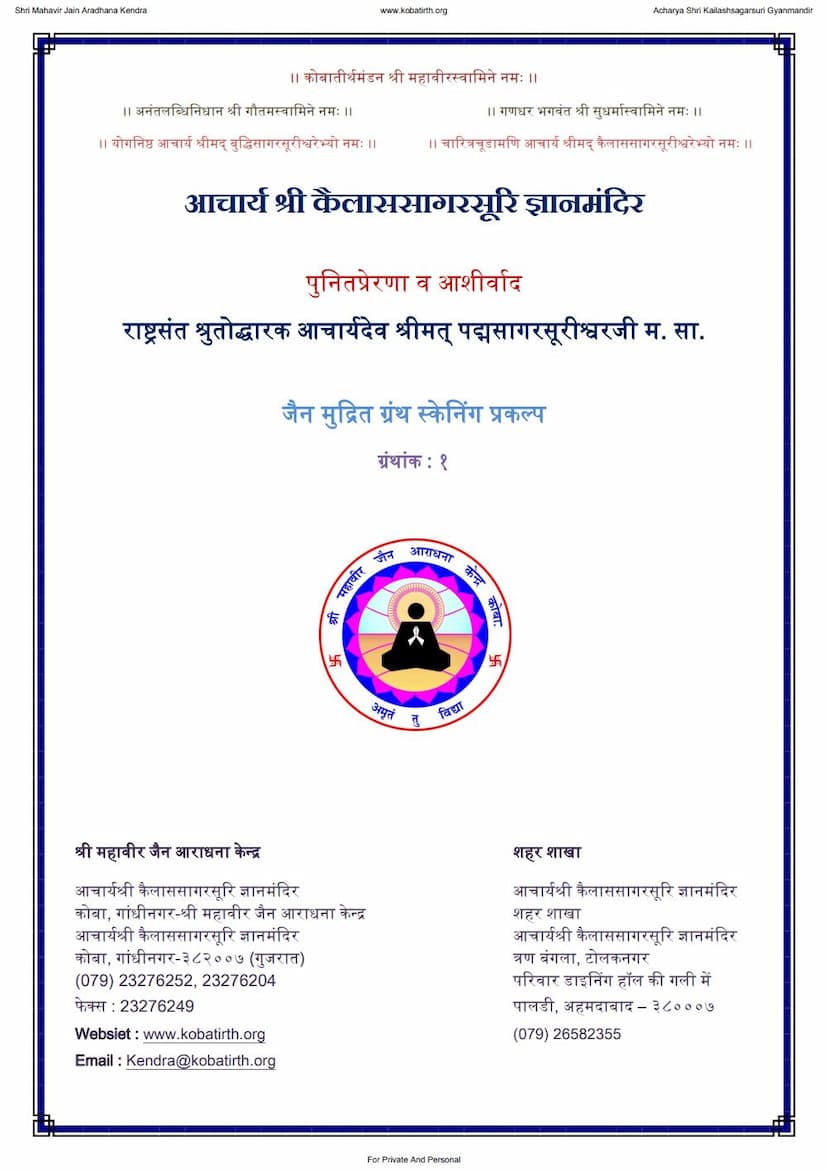Agam 03 Ang 03 Sthanang Sutra Shwetambar
Added to library: September 1, 2025

Summary
The provided text is a significant portion of the Sthananga Sutra, specifically Agam 03, Ang 03, from the Shwetambar canon of Jainism. The scanned pages contain the original Prakrit text, along with introductory and contextual information in Gujarati and Hindi, and acknowledgments of those involved in the publication and scanning process.
Here's a comprehensive summary of the content, focusing on the philosophical and classificatory nature of the Sthananga Sutra:
Overall Purpose and Structure:
The Sthananga Sutra is a fundamental Jain scripture that systematically classifies and enumerates various aspects of Jain philosophy, cosmology, ethics, and spiritual practice. Its unique methodology is to categorize everything into 'places' (Sthana), typically presenting concepts in numerical order, most commonly in groups of twos, threes, fours, fives, sixes, sevens, eights, nines, and tens. This makes it a vast encyclopedic work, offering a structured understanding of the Jain worldview.
Key Themes and Content (as reflected in the scanned pages):
-
Enumeration and Classification: The sutra's core is the enumeration of Jain principles, entities, and practices. The scanned text begins with a series of 'places' or categories, often presented in a dualistic manner (e.g., 'one existence', 'one staff', 'one action'). This pattern continues throughout the text, demonstrating the Jain emphasis on comprehensive classification.
-
Duality and Triality: Many concepts are presented in pairs (e.g., 'one existence and non-existence', 'pure and impure', 'life and non-life'). There's also frequent use of threes (e.g., 'three types of karma', 'three types of knowledge') and higher numerical categories.
-
Cosmology and Geography: Significant portions of the sutra delve into the Jain cosmology, describing the various levels of the universe (Jambudvipa, Dhātakikhanda, Puṣkarārdha), the mountains (Meru, Himavanta, etc.), rivers, oceans, celestial beings (Devas), and realms (hells, heavens). The text meticulously lists locations, their dimensions, and the beings inhabiting them. The enumeration of various classes of beings, from hell-dwellers (Narakas) to celestial beings (Devas), their lifespans, characteristics, and locations, is a prominent feature.
-
Karma Theory: The sutra details the various types of karma (e.g., Jnanavarniya, Darshanavarniya, Mohaniya, Ayushya, Nama, Gotra, Antaraya), their causes, effects, and classifications. The concepts of bondage (bandha), manifestation (udaya), and liberation (nirjara) are implicitly or explicitly discussed.
-
Jain Ethics and Conduct: The text enumerates virtues and vices, the nature of sins (papa) and merits (punya), the categories of vows (vratas), and the stages of spiritual progress. It describes the conduct of monks (Sadhus) and nuns (Sadhvis), including their daily routines, austerities, and the principles governing their actions. The concept of the soul (Jiva) and its attributes, as well as non-soul (Ajiva) categories, are central.
-
Knowledge (Jnana) and Perception (Darshana): The sutra classifies different types of knowledge (e.g., mati, shruta, avadhi, manahparyaya, kevala) and perception, outlining their characteristics and the means to attain them.
-
Time and Cycles: Jain cosmology includes detailed descriptions of time cycles, epochs (kalpas), and their subdivisions, contributing to the cyclical view of existence.
-
The Concept of 'Sthanang' (Places): The title itself signifies the book's method. It systematically categorizes every conceivable aspect of existence into 'places' or 'categories'. For example, there are 'places' of birth, 'places' of existence, 'places' of knowledge, 'places' of conduct, and so on.
-
Introductory and Acknowledgment Pages: The initial pages provide context for the publication, honoring the lineage of Acharyas and the individuals involved in the project. This includes blessings from various spiritual leaders and acknowledgments for the scanning and publishing efforts by Jain establishments. The language used in these sections is primarily Gujarati and Hindi.
Specific Numerical Categories Highlighted (from the scanned text):
The scanned pages provide numerous examples of numerical classifications:
- Duality (Two): Mention of dual nature of souls, karmas, causes, etc.
- Triality (Three): Discussion of three types of karma, three types of hells, three classes of beings, etc.
- Quadrinity (Four): Enumeration of four types of knowledge, four types of karma, four cardinal directions, four types of causes for attachment, etc.
- Quintet (Five): Sections detailing five types of vows, five senses, five types of conduct, five pillars of Jainism (Pancha Mahavratas), five types of hells, etc.
- Sextet (Six): Discussion of the six types of souls (Jivas), six karmas, six directions, the six eternal substances (Dravyas), six stages of spiritual development, etc.
- Septet (Seven): Enumeration of seven types of karmas, seven hellish realms, seven major mountains, seven types of knowledge, etc.
- Octet (Eight): Mention of eight types of karmas, eight types of speech, eight directions of space, etc.
- Nonet (Nine): Discussion of nine types of souls, nine classes of celestial beings, nine cardinal virtues, etc.
- Decade (Ten): Enumerable concepts are presented in tens, such as ten types of senses, ten stages of spiritual progress, ten types of knowledge, etc.
In essence, the Sthananga Sutra is a monumental work of Jain systematization. It meticulously lays out the Jain understanding of reality by breaking it down into quantifiable and classifiable elements. The scanned portion showcases this detailed approach, covering a vast range of topics from the fundamental nature of existence to the intricacies of the cosmos and the path to liberation. The sheer volume of enumeration suggests the sutra's aim to leave no aspect of the spiritual and material world unaddressed within its classificatory framework.